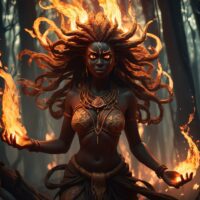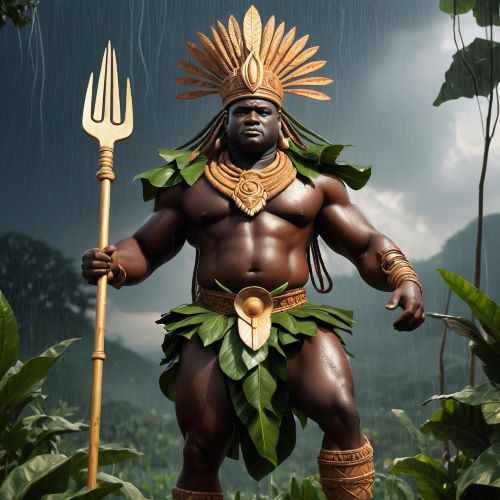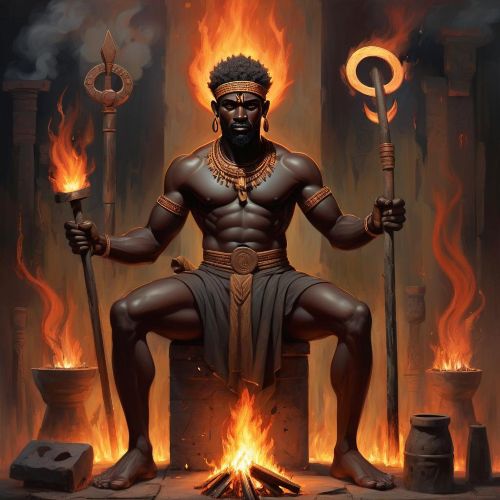Nyale : Goddess of Fire
Listen
At a glance
| Description | |
|---|---|
| Origin | Bambara Mythology |
| Classification | Gods |
| Family Members | N/A |
| Region | Mali |
| Associated With | Fire |
Nyale
Introduction
In Bambara mythology, Nyale is a striking and paradoxical figure, embodying both destruction and renewal. The Bambara people of Mali hold a rich cosmology in which the universe is sustained by a balance of opposing principles. Within this system, Nyale symbolizes chaotic energy, uncontrolled urges, and the primal forces of creation. Her presence stands in contrast to Faro, the deity of order, rationality, and water. Nyale is part of a divine quaternity alongside Pemba, Faro, and Ndomadyiri, all of whom represent core elements of existence. Together they form aspects of Bemba, the great creator. In this way, Nyale is more than just a goddess of chaos—she is a vital component of the Bambara worldview, representing transformation and the power of raw, untamed energy.
Physical Traits
Descriptions of Nyale’s physical form are rare, as Bambara mythology often emphasizes symbolic roles over literal depictions. In her earlier form as Musukoroni, however, she is portrayed as a fiery and unsettling entity born from the decay of Pemba’s cosmic tree. Emerging from mildew and spittle, she embodies impurity, chaos, and transformation. This origin story emphasizes her organic, almost elemental birth, suggesting she is less a being of flesh and more a manifestation of cosmic imbalance.
Unlike Faro, who is often associated with clarity and order, Nyale is elusive, mysterious, and ever-shifting. Over time, she transitions into a goddess of fertility, where her form is linked with abundance, growth, and the earth’s capacity to renew itself. This duality—shifting between destructive fire and nurturing fertility—marks her as a deity who cannot be confined to a single appearance. Instead, she embodies cycles of change, reflecting the natural rhythm of death, decay, and rebirth.
Family
Nyale is deeply tied to the divine family that structures Bambara cosmology. She is one of the four manifestations of Bemba, the hermaphroditic creator, who embodies the totality of existence. Alongside Pemba, Faro, and Ndomadyiri, she represents one part of the universe’s foundational principles. Nyale is often paired with Pemba, described as her twin or consort, forming a dynamic sibling-spouse relationship that symbolizes the merging of male and female energies.
Where Pemba represents the heavens, air, and initial creation, Nyale embodies fire, chaos, and later fertility. Their union is both cooperative and conflictual, reflecting the tension between order and disorder that drives the cosmos forward. This mythological relationship illustrates the Bambara belief in balance—where chaos cannot exist without order, and life cannot thrive without the risk of destruction.
Other names
Nyale is also known by alternative names, most notably Musukoroni or Mouso Koroni Koundyé, which highlight her more volatile and destructive aspect. Under this identity, she is remembered as a goddess of chaos, fire, and secrecy, one who acts as the primordial disruptor. In some traditions, she is also referred to as the First Sorcerer, credited with the earliest use of spiritual and magical power. This title links her to knowledge of hidden forces, transformation, and the esoteric practices that shape Bambara spirituality.
Beyond Bambara mythology, the name “Nyale” takes on entirely different meanings in other cultures. In Lombok, Indonesia, Nyale refers to the sea worms that appear seasonally in great numbers, inspiring the annual Bau Nyale festival. The worms themselves are symbols of abundance and continuity, tied to local legend. Though unrelated to the Bambara goddess, this usage reflects how the term “Nyale” resonates across traditions as a symbol of fertility, transformation, and communal identity.
Powers and Abilities
Nyale’s powers are rooted in elemental force and spiritual duality. As Musukoroni, she embodies fire and chaos, representing destruction, transformation, and the unpredictable nature of existence. Her energy is disruptive, breaking down order and opening pathways for renewal. At the same time, Nyale is credited with creating all living beings on Earth, highlighting her role as a mother of creation.
Her transformation from chaos-bringer to fertility goddess emphasizes her dual role in shaping life. She not only holds destructive power but also nurtures abundance, reproduction, and growth. In addition, her title as the First Sorcerer associates her with mystical knowledge, secrecy, and the hidden energies that connect humans with the divine. This blend of fertility, sorcery, and fire makes Nyale a liminal figure—one who stands between creation and destruction, embodying both ends of the cosmic spectrum.
Modern Day Influence
Nyale’s legacy, though tied to the traditional beliefs of the Bambara, continues to resonate in cultural and intellectual ways. In Mali, Bambara cosmology still influences rituals, oral storytelling, and symbolic art. Masks, textiles, and ceremonial objects often carry motifs that reflect the balance between chaos and order, with Nyale serving as an archetype of fiery, transformative power. Scholars of comparative mythology frequently connect Nyale to other goddesses of fire and chaos, such as Kali in India, Pele in Hawaii, and Sekhmet in Egypt, highlighting her place in a global pattern of deities who embody destruction as a precursor to renewal.
In broader cultural studies, Nyale is interpreted as an archetype of the “dark feminine,” a figure that represents hidden desires, secrecy, and creative potential emerging from chaos. This interpretation has found resonance in feminist and psychoanalytic readings of mythology, where she embodies the power of suppressed energies and the necessity of disorder in the cycle of growth.
Outside of Africa, the name Nyale carries significance in Lombok, Indonesia, where the Bau Nyale festival celebrates the seasonal appearance of sea worms. This event, tied to the legend of Princess Mandalika, is a major cultural and religious occasion that blends ecological awareness with mythological storytelling. The worms, called Nyale, symbolize fertility and abundance, and the festival itself has become an important part of Lombok’s tourism economy. While unrelated to Bambara beliefs, this living tradition highlights how the concept of Nyale continues to embody themes of renewal, sacrifice, and communal unity.
Scientific research has also engaged with Nyale in its Indonesian context, studying the worms’ antibacterial properties, amino acid profiles, and potential for sustainable food practices. These investigations demonstrate how a name rooted in mythology can bridge into fields of ecology, medicine, and education. For instance, Nyale worms are used in authentic inquiry projects to teach critical thinking and creativity to science students, proving that the mythological resonance of Nyale extends even into modern scientific discourse.
Related Images
Source
Camara, L. (1990). Camara Laye’s L’enfant noir and the Mythical Verb.
Efoui, K. (2007). Contemporary Francophone drama: Between detours and deviations.
Ndlovu-Gatsheni, S. J., & Zvobgo, R. J. (2022, January 1). Stereotyping, Exploitation, and Appropriation of African Traditional Religious Beliefs: The Case of Nyaminyami, Water Spirit, among the Batonga People of Northwestern Zimbabwe, 1860s–1960s.
HandWiki. (n.d.). Religion: Bemba (mythology). Retrieved September 18, 2025, from https://handwiki.org/wiki/Religion:Bemba_(mythology)
Wikipedia. (n.d.). Bemba (deity). Retrieved September 18, 2025, from https://en.wikipedia.org/wiki/Bemba_(deity)
Mythosphere. (n.d.). Bambara Mythology. Retrieved September 18, 2025, from https://www.folklore.earth/culture/bambara/
Frequently Asked Questions
What is lorem Ipsum?
I am text block. Click edit button to change this text. Lorem ipsum dolor sit amet, consectetur adipiscing elit. Ut elit tellus, luctus nec ullamcorper mattis, pulvinar dapibus leo.
What is lorem Ipsum?
I am text block. Click edit button to change this text. Lorem ipsum dolor sit amet, consectetur adipiscing elit. Ut elit tellus, luctus nec ullamcorper mattis, pulvinar dapibus leo.
What is lorem Ipsum?
I am text block. Click edit button to change this text. Lorem ipsum dolor sit amet, consectetur adipiscing elit. Ut elit tellus, luctus nec ullamcorper mattis, pulvinar dapibus leo.
What is lorem Ipsum?
I am text block. Click edit button to change this text. Lorem ipsum dolor sit amet, consectetur adipiscing elit. Ut elit tellus, luctus nec ullamcorper mattis, pulvinar dapibus leo.
What is lorem Ipsum?
I am text block. Click edit button to change this text. Lorem ipsum dolor sit amet, consectetur adipiscing elit. Ut elit tellus, luctus nec ullamcorper mattis, pulvinar dapibus leo.








